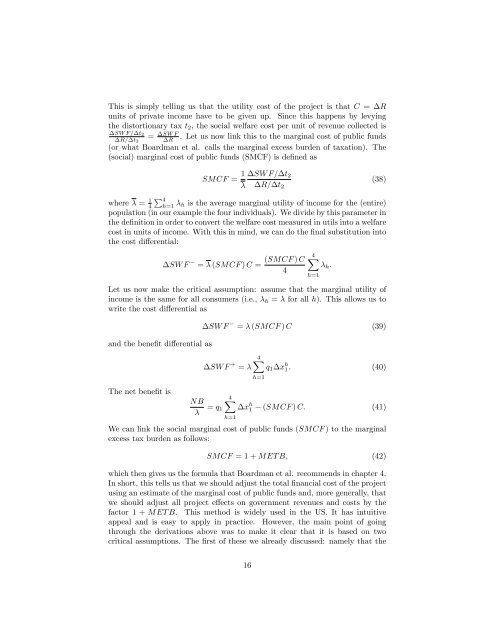Lecture Note 15: Social Cost Benefit Analysis - University of ...
Lecture Note 15: Social Cost Benefit Analysis - University of ...
Lecture Note 15: Social Cost Benefit Analysis - University of ...
You also want an ePaper? Increase the reach of your titles
YUMPU automatically turns print PDFs into web optimized ePapers that Google loves.
This is simply telling us that the utility cost <strong>of</strong> the project is that C = R<br />
units <strong>of</strong> private income have to be given up. Since this happens by levying<br />
the distortionary tax t2, the social welfare cost per unit <strong>of</strong> revenue collected is<br />
SW F= t2 SW F<br />
R= = t2 R . Let us now link this to the marginal cost <strong>of</strong> public funds<br />
(or what Boardman et al. calls the marginal excess burden <strong>of</strong> taxation). The<br />
(social) marginal cost <strong>of</strong> public funds (SMCF) is de…ned as<br />
SMCF =<br />
1 SW F= t2<br />
R= t2<br />
(38)<br />
where = 1 P4 4 h=1 h is the average marginal utility <strong>of</strong> income for the (entire)<br />
population (in our example the four individuals). We divide by this parameter in<br />
the de…nition in order to convert the welfare cost measured in utils into a welfare<br />
cost in units <strong>of</strong> income. With this in mind, we can do the …nal substitution into<br />
the cost di¤erential:<br />
SW F = (SMCF ) C =<br />
(SMCF ) C<br />
4<br />
Let us now make the critical assumption: assume that the marginal utility <strong>of</strong><br />
income is the same for all consumers (i.e., h = for all h). This allows us to<br />
write the cost di¤erential as<br />
and the bene…t di¤erential as<br />
The net bene…t is<br />
NB = q1<br />
4X<br />
h=1<br />
SW F = (SMCF ) C (39)<br />
SW F + =<br />
4X<br />
h=1<br />
4X<br />
q1 x h 1: (40)<br />
h=1<br />
x h 1 (SMCF ) C: (41)<br />
We can link the social marginal cost <strong>of</strong> public funds (SMCF ) to the marginal<br />
excess tax burden as follows:<br />
SMCF = 1 + MET B; (42)<br />
which then gives us the formula that Boardman et al. recommends in chapter 4.<br />
In short, this tells us that we should adjust the total …nancial cost <strong>of</strong> the project<br />
using an estimate <strong>of</strong> the marginal cost <strong>of</strong> public funds and, more generally, that<br />
we should adjust all project e¤ects on government revenues and costs by the<br />
factor 1 + MET B. This method is widely used in the US. It has intuitive<br />
appeal and is easy to apply in practice. However, the main point <strong>of</strong> going<br />
through the derivations above was to make it clear that it is based on two<br />
critical assumptions. The …rst <strong>of</strong> these we already discussed: namely that the<br />
16<br />
h:


